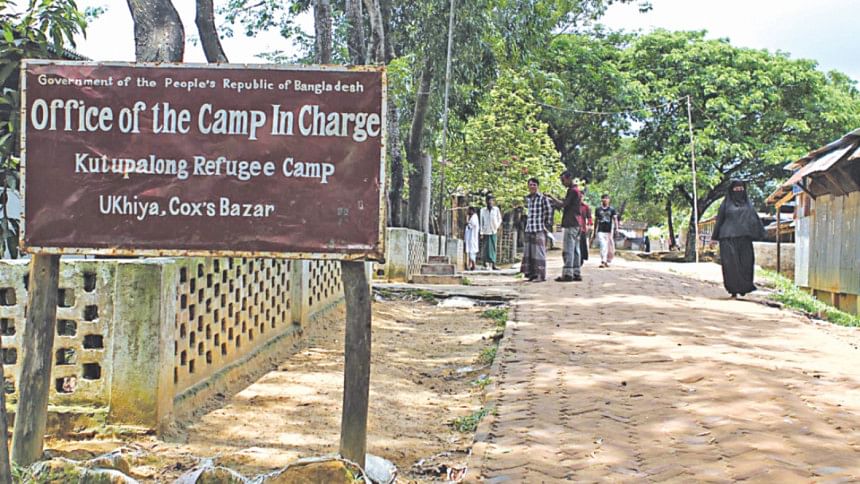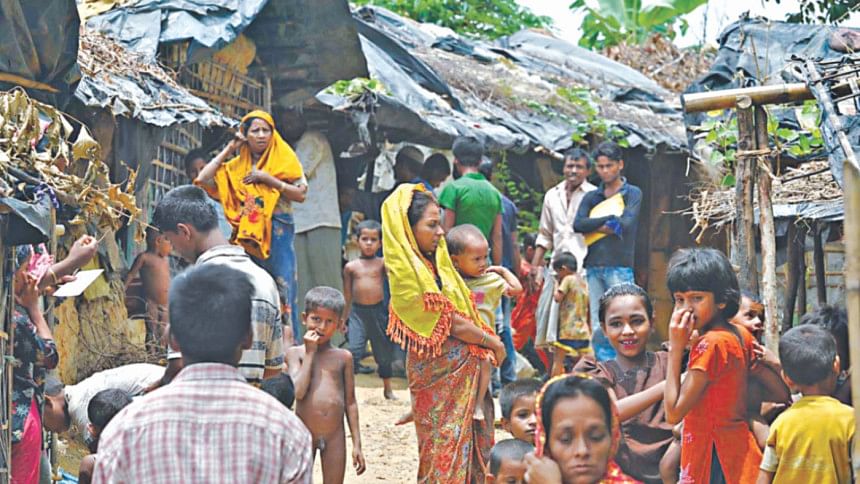Global migration crisis and the Bangladesh experience

More than 1 million refugees have entered Europe by land and sea in 2015. The mass exodus of people from North Africa and Middle East have made the migrant crisis Europe's worst since World War II. While more than 80% of the migrants have arrived by sea routes, the fierce winter has not been able to slow down the daily influx, particularly in Greece. Europe has been struggling to deal with these large groups of helpless people, registering them as migrants and refugees, catering to their basic needs of shelter and food. In many stances, relocation of the migrants to share burden among the EU nations have failed due to resistance from both some of the EU countries as well as migrants who wanted to migrate to their country of choice. Hence, balancing the crisis has become a key challenge for Europe both socially and economically.
While there is ongoing debate on Europe's policy on refugee management, Bangladesh has experience and learnings from the successful refugee migration and repatriation in a number of cases. During the liberation war in 1971, approximately 10 million refugees from Bangladesh fled to neighbouring India facing brutal aggression by the Pakistani military force. After the 9-month-long war ended, they were successfully repatriated back to their homeland. Bangladesh also has successfully managed the waves of Rohingya refugees who have fled from Myanmar at different stages in time. Despite resource constraints, Bangladesh has successfully repatriated majority of the refugees through mass repatriation and provided citizenship to many of them who chose to stay back. Even in the context of Biharis, a large portion of the minority chose to stay back after 1971; many of them in recent years have applied of citizenship and have been granted. Hence, the country has a strong record of success stories in dealing with migrant flow as both the source and destination country. These case studies could provide substantial learning evidence for bothpragmatic policy resolution as well as effective means to deal with the migrant crisis facing Europe.
In the face of Pakistani aggression on Bengali civilians of the then East Pakistan, millions of Bengali refugees fled to the bordering states of India, particularly West Bengal, Tripura, Meghalaya and Assam. The humanitarian and economic crisis faced by the Bengalis was overwhelming as hundreds of refugee camps were established along the Indo-Bangladesh border that sheltered the impoverished and panic stricken people of Bangladesh. India provided training and healthcare support to the MuktiBahini and bolstered the diplomatic movement for Bangladesh's acceptance as a new country in the world map. By the end of the war, repatriation of refugees began; starting in early December 1971 and eventually gaining speed after the surrender of Pakistani Army on the 16 of the month, the mass repatriation of over 9million refugees was complete by February 1972. This was largest mass repatriation operation after World War II, accomplished with the UNHCR and coordinated efforts on both sides of the border.
Even though majority of the refugees did not have food and shelter in their newly liberated country, they accomplished the repatriation actively and willingly travelling by foot, rickshaws, vans, bicycles, trucks, buses and trains. The refugees were provided with food for the journey, medical assistance, and two weeks' basic rations during their return. 271 transit camps were set up to provide medical services, food rations and free transport. By the end of 1972, USD 6.3 million worth of repatriation contributions were transferred to Bangladesh government to finance relief and rehabilitation of the returnees.
UNHCR endorsed an agreement between the Indian Red Cross and the Bangladesh Red Cross to transfer equipment and supplies to nutritional centres for use at the transit and rehabilitation camps in Bangladesh. However, many of the refugees returned directly to their communities without registration at either of the camps across the two neighbouring countries. The UNHCR liaison office in Dhaka worked closely with the United Nations East Pakistan Relief Operation to coordinate the international aid and assistance since the cyclone in 1970. The mass repatriation in Bangladesh was one of the major ones that took place in the 1970s including some 300,000 refugees returning to Cambodia mainly from Thailand in 1979, and some 200,000 Rohingyas from Bangladesh to Myanmar in a more controversial operation in 1978-79. Repatriation has been a common phenomenon in the Third World as a gesture of support and assistance; integration into new societies and permanent migration is not the only solution even in the case of Europe. In 1978, religious and sectarian conflict spurred in Burma after the Operation Nagmin led to the prosecution of thousands of Rohingya and Chinese minorities. The sudden rise in the number of arrests and harassment of the Arakanese Muslims, often accompanied by use of brute force, after a long period of sectarian intolerance resulted in the mass exodus of the Rohingyas into Bangladesh.
The Bangladesh government claimed that 252,000 Rohingyas sought refuge in 11 refugee camps, while the numbers quoted by Burmese official sources were much less. During June-July 1978, the two neighbours settled for a repatriation agreement which resulted in the return of 187,250 refugees to Myanmar between the months of August and December. The process was highly controversial as international authorities suspected forced and induced return of the Rohingyas. However, due to continued conflict in Myanmar, Bangladesh faced another mass influx of about 250,000 Rohingya refugees in the year 1991 in the coastal districts of Teknaf, Ramu, Ukhia and Cox's Bazar.
The second round of refugee movement was initially considered as a short term problem by the Bangladesh government and hence they were provided with temporary shelters, food, medical and health care services and sanitation facilities. However, soon it was realised to be a bigger burden that led to subsequent negotiations with the government of Myanmar and signing of a Joint Statement for repatriation. Repatriations during 1992 were alleged forcible and faced protests by UNHCR and other NGOs. As a result, UNHCR withdrew from the program in December 1992 and the controversial coercion for repatriation continued and another 50,000 people were sent back by 1994.

Global criticisms eventually changed the internal dynamics of the Rohingya refugee treatment in Bangladesh and UNHCR was once again involved in the process to interview refugees on their willingness to return. Soon the rate of monthly repatriation picked up accompanied by change of policy within the UNHCR to provide for mass registration of repatriation by refugees that indicate about 90 percent of the returnees after 1994 said "yes" to repatriation. Today, more than 200,000 Rohingya refugees reside in Bangladesh, while only about 33,000 of them are supported by UNHCR. The government of Bangladesh began the official census in to determine the number of unregistered Rohingya refugees, many of whom have been reintegrated into the Bangladeshi society.
Similar is the case for Biharis who have been living in Bangladesh since 1971. Non-Bengali Pakistani Muslims, a majority of whom originate from the Indian State of Bihar before partition in 1947, are mainly referred to as Biharis. In 1973, the governments of India, Pakistan and the newly liberated Bangladesh signed the trilateral New Delhi Agreement which incorporated the repatriation of three major groups of people, namely, Pakistani prisoners of war and civilian internees in India, all Bengalis in Pakistan, and Biharis in Bangladesh. The United Nations assisted the repatriation through UNHCR working closely with the Red Cross, resulting in the movement of 90,000 people from Pakistan to Bangladesh, and over 44,000 from Bangladesh to Pakistan by January 1974. By February, over 200,000 refugees had been repatriated under the agreement. This mass repatriation played a significant role in Pakistan recognising Bangladesh as sovereign nation on 22 February 1974 and the beginning of diplomatic relations.
Over the years the Biharis, mainly living in the refugee camps grew in number. Their economic activities and lifestyle gradually reintegrated into the Bengali society despite the presence of a certain degree of social exclusion. The Biharis have been living in Bangladesh in a peaceful manner with little or no uprising/struggle for repatriation. In 2007, the Bangladesh government made provisions for a new policy to provide citizenship to the Biharis or Urdu-speaking people born after the time of independence in Bangladesh upon application. In May 2008, the Dhaka High Court declared 150,000 Urdu-speaking Muslim refugees as Bangladeshi citizens with voting and every other constitutional right. However, many of the first generation Biharis still possess the wish to repatriate to Pakistan while second and third generation members of this community who have been well integrated into the society opt to claim rights as citizens and continue settlement in the country they know as home.
Bangladesh being a third world country have time and again proved to be sensitive to refugee issues. Any form of refugee crisis has been considered a humanitarian crisis rather than an economic and social burden. With the support of global aid and international support, such display of sensitivity can also be learned by some of the European nations too concerned about preserving their ethnic identity at the expense of humanity. Crisis in Syria is far from resolved and migrants from other destinations as well are being sent back to their place of origin to keep the pressure under control.
Under such circumstances, European policies could manoeuvre a softer approach to the migrants instead of strengthening border control and making people endure the European winter under open sky and freezing temperature. Helpless boat people of the Mediterranean can be saved from being drowned with concerted international support emanating from all stakeholders- political leaders, business community, NGOs, social activists, and media. Reintegration of some refugees in the long run into the European society is still an option for a continent which is in need of a working population as it struggles to provide for a relatively larger population of elderly citizens who have retired from active service.
What Bangladesh has shown is that for effectively responding to the refugee crisis, it is not the resources and geopolitical clout that matters most as the country is not strong in either counts. What matters most is the human dimension of the problem and the political willingness to be responsive to a humanitarian crisis with both humanism and pragmatism. On all these counts, Bangladesh has done much better than anyone could have done under similar circumstances and resource constraints.
The author is a Professor at the Institute of Business Administration (IBA), University of Dhaka

 For all latest news, follow The Daily Star's Google News channel.
For all latest news, follow The Daily Star's Google News channel. 



Comments